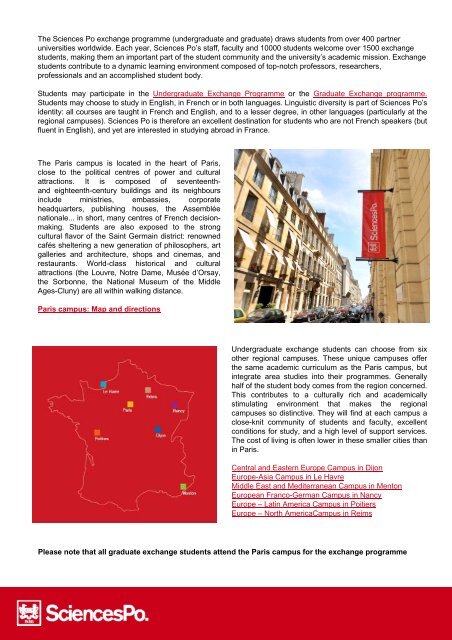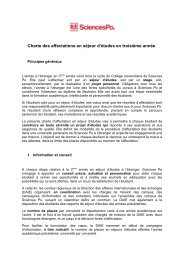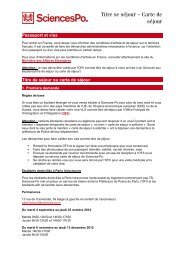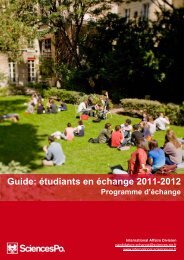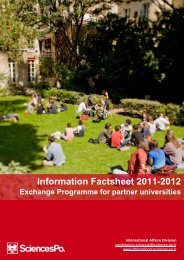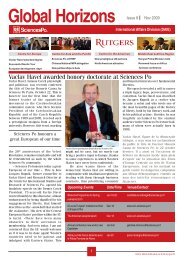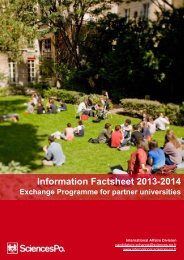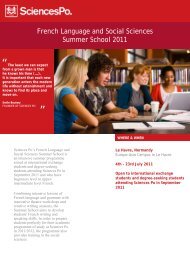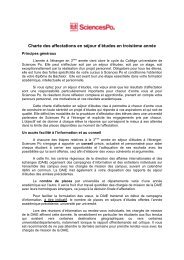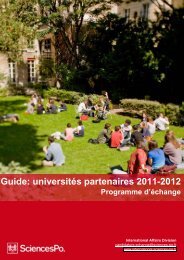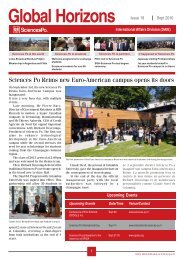Fact sheet - Sciences-Po International
Fact sheet - Sciences-Po International
Fact sheet - Sciences-Po International
Create successful ePaper yourself
Turn your PDF publications into a flip-book with our unique Google optimized e-Paper software.
The <strong>Sciences</strong> <strong>Po</strong> exchange programme (undergraduate and graduate) draws students from over 400 partneruniversities worldwide. Each year, <strong>Sciences</strong> <strong>Po</strong>’s staff, faculty and 10000 students welcome over 1500 exchangestudents, making them an important part of the student community and the university’s academic mission. Exchangestudents contribute to a dynamic learning environment composed of top-notch professors, researchers,professionals and an accomplished student body.Students may participate in the Undergraduate Exchange Programme or the Graduate Exchange programme.Students may choose to study in English, in French or in both languages. Linguistic diversity is part of <strong>Sciences</strong> <strong>Po</strong>’sidentity: all courses are taught in French and English, and to a lesser degree, in other languages (particularly at theregional campuses). <strong>Sciences</strong> <strong>Po</strong> is therefore an excellent destination for students who are not French speakers (butfluent in English), and yet are interested in studying abroad in France.The Paris campus is located in the heart of Paris,close to the political centres of power and culturalattractions. It is composed of seventeenthandeighteenth-century buildings and its neighboursinclude ministries, embassies, corporateheadquarters, publishing houses, the Assembléenationale... in short, many centres of French decisionmaking.Students are also exposed to the strongcultural flavor of the Saint Germain district: renownedcafés sheltering a new generation of philosophers, artgalleries and architecture, shops and cinemas, andrestaurants. World-class historical and culturalattractions (the Louvre, Notre Dame, Musée d’Orsay,the Sorbonne, the National Museum of the MiddleAges-Cluny) are all within walking distance.Paris campus: Map and directionsUndergraduate exchange students can choose from sixother regional campuses. These unique campuses offerthe same academic curriculum as the Paris campus, butintegrate area studies into their programmes. Generallyhalf of the student body comes from the region concerned.This contributes to a culturally rich and academicallystimulating environment that makes the regionalcampuses so distinctive. They will find at each campus aclose-knit community of students and faculty, excellentconditions for study, and a high level of support services.The cost of living is often lower in these smaller cities thanin Paris.Central and Eastern Europe Campus in DijonEurope-Asia Campus in Le HavreMiddle East and Mediterranean Campus in MentonEuropean Franco-German Campus in NancyEurope – Latin America Campus in <strong>Po</strong>itiersEurope – North AmericaCampus in ReimsPlease note that all graduate exchange students attend the Paris campus for the exchange programme


